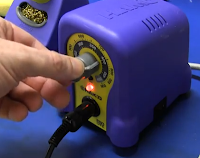Find a need:
In the absence of the original 9V AC power supply required by the Atari XF-551 5.25 diskette drive, I decided to modify it to a brickless version.
Fill a need:
Since the diskette drive is a standard IDE, we can use a standard IDE power supply (Any power brick capable of 15V and 2A should suffice.
First test: Will this work?
Note that if you feed the drive mechanism directly, you will not be feeding the main board of the XF-551, which means you will need to send power back to the board as you see in the picture below. The blue, red and green jumper wires are taking power from the connector board on the drive unit and sending it back through the original IDE connector and through the white ribbon wire to the main board.
Q: This is a power brick that supplies both 5V and 12V. Can I use something that provides only 12V?
While you can connect the power supply to the output of the 12V regulator and 5V regulator in the case your power can supply both voltages, you can't use a single 12V power supply and connect it to the OUTPUT OF THE RECTIFIER BRIDGE, which is a large dice attached to the dissipator. The reason being that you can't feed a 12V regulator with 12V.
You actually may be able to make it work with 12V to feed the whole board and drive, but chances are that the 12V regulator on the XF551 will deliver only 8 or 9V, which means your drive will be able to read diskettes but NOT WRITE or format anything.
Bottom line, if you can't find something that provides both 12 AND 5v, go for a 15 V or greater power supply. The on-board regulators will take it from there.
Now for the final mod in 10 simple steps:
There's a great space on the board, just inside the big heat dissipator to place this power unit.
1) Crack open the plastic case of your PSU, and use the guts, otherwise it will not fit in the drive.
2) De-solder and remove the original 9VAC jack on the main board of the XF-551 to avoid any accidental power supply mixture.
3) Hook the 12V line of the power brick to the 12V output of the 12V onboard regulator and the 5V line of your power brick to the output of the 5V regulator on the XF551.
4) Hook the GND line of the power brick to the GND on the main board of the XF-551.
5) Note that the rear switch has been disabled because the power jack was removed.
6) Pass the AC high voltage cable through the hole left by the absent power jack, and squeeze it with a zip tie to prevent accidental pulling.
7) Solder the mains power cable to the power brick.
8) Isolate the bottom of the power brick with tape and/or cardboard.
9) Stick the power brick to the original heat dissipator using double sided tape.
10) This may get hot, so a small fan will help to keep things cool.
Picture below shows how yellow cable feeds 12V to the output of the regulator, while the RED wire feeds 5V to the output of the 5V regulator.
and voliá the PSU inside the XF:
Isolation is important. This is live voltage. I isolated the bottom side of the PSU board with cardboard and tape. That's in case the heat melts down the glue and the PSU ends up falling on top of the main XF board.
Make sure the bottom part of the PS is adequately isolated.
You can see there's not a lot of weight added to the unit, and the result is as practical as you see below. The power plug in this particular case is a CEE 7/16 Europlug for 220VAC used by some countries in South America and Europe:
Ah.... there's one more thing.
The XF-551 LED mod.
Now that your XF is open, add a red LED with a 330Ohm resistor. Hook it up to the 5V line and place the LED RIGHT BEHIND THE ORIGINAL LED.
The effect is the same as a bi-color LED. The new addition will lit as long as your disk drive has power.
When the drive is spinning, the green (original) led will light up, but it will mix colors with the existing RED led, providing a nice orange color.
Now you know when your drive is both powered and active, just like the 1050.
Enjoy!



























